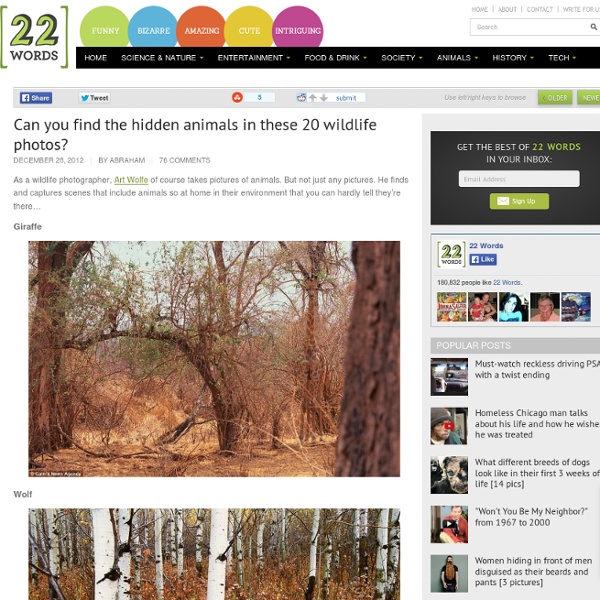Can you find the hidden animals in these 20 wildlife photos?
As a wildlife photographer, Art Wolfe of course takes pictures of animals. But not just any pictures. He finds and captures scenes that include animals so at home in their environment that you can hardly tell they’re there… Giraffe Wolf Willow Ptarmigan Caiman Great Horned Owl American Pika Blue-crowned Parrot Horned Adder Leopard Gyrfalcon California Ground Squirrel Spotted Deer Impala Cheetah Common Snipe Wandering Tattler Nighthawk Coyote Klipspringers Blue Dacnis Related… (via The Daily Mail)
An Ant Diversity Sampler - MYRMECOS - Insect Photography
[the following is a repost from Scienceblogs] With 12,000 described species, ants dominate global terrestrial ecosystems. Here are a few of them. Name: Nothomyrmecia macrops Distribution: Australia Famous for: The story of its rediscovery (As told by Bill Bryson)
Enter the Wild » Pulp Vulture
Share this:
Oh They're So Surprised!
Oh They’re So Surprised! Posted by SHMO on November 5, 2012 · 124 Comments What if the animal kingdom could understand the dramatic presidential election? What if they could comprehend the shocking nightly news? …We figured they might look like this…
Unexpected Friends
Cute A bear, a tiger and a lion. They’re dangerous predators, but they’re friends. The reason they do not attack each other or consider the other as rivals, is that they were brought up together. Source
new week nudibranch Archives
Habitat: Hong Kong and eastern Australia (New South Wales to the northern Great Barrier Reef) as well as New Caledonia Status: Not Listed Pictures can… Read Article → Habitat: Tropical Indo-West Pacific Status: No Conservation Concerns Check out this itty-bitty nudibranch beauty! It’s a Chromodoris fidelis which only grows to between 20-25 mm… Habitat: Malaysia, western Australia, Fiji, New Guinea, Indonesia and New Caledonia and the Kerama Islands of Japan Status: No Conservation Concerns This handsome nudibranch is… Habitat:Big Island, Maui, Kahoolawi, Molokai, Oahu, Kauai and French Frigate Shoals: widely distributed in the Indo-Pacific Status: No Conservation Concerns Is this not the sweetest… Habitat: West Coast of Nth America from Oregon south to Baja California Status: No Conservation Concerns The Hopkin’s Rose nudibranch one of the wildest nudis…
More Than Human: Tim Flach's Striking Portraits of Animals
“More Than Human” is a series of photos from the book of the photographer Tim Flach. Photographer uses studio lighting and decor to catch those moments when the animals in their posture or look the most similar to humans. I am sure you will like this awesome "More than human" photo project. :P (32 Photos) * Must visit the underwater dogs photography Photo Credit: Tim Flach
Iconaster longimanus
Animals Illuminated by the Sun
The time of sunset is defined in astronomy as the moment when the trailing edge of the Sun’s disk disappears below the horizon in the west. There are few things in nature as photogenic as the sky at sunset, especially animals. The rich bright gold, pink and orange colors make unusually beautiful pictures of animals illuminated by the sun. Source Source Source Source Source Source Source Source Source Source Source Source Source
Vampire squid from hell eats faeces to survive depths
While most vampires prefer their prey alive, vampire squid are rather less demanding. They munch on any dead plankton, crustacean remains and faecal matter that happens to pass by, making them the only cephalopod not to hunt living prey. Vampyroteuthis infernalis – literally the "vampire squid from hell" – has a pair of thin, retractable filaments. It uses them like a fishing line, letting them drift and collect bits of waste. This diet, unique among cephalopods, allows the squid to live in environments that are too difficult for most predators to survive in, says Henk-Jan Hoving at the Monterey Bay Aquarium Research Institute in California. Other squid and octopuses use their suckers and strong arms to capture prey, but the vampire squid's passive approach to finding food means it does not have to spend energy building muscles and chasing down live animals. Journal reference: Proceedings of the Royal Society B, DOI: 10.1098/rspb.2012.1357 More From New Scientist More from the web
Related:
Related:



